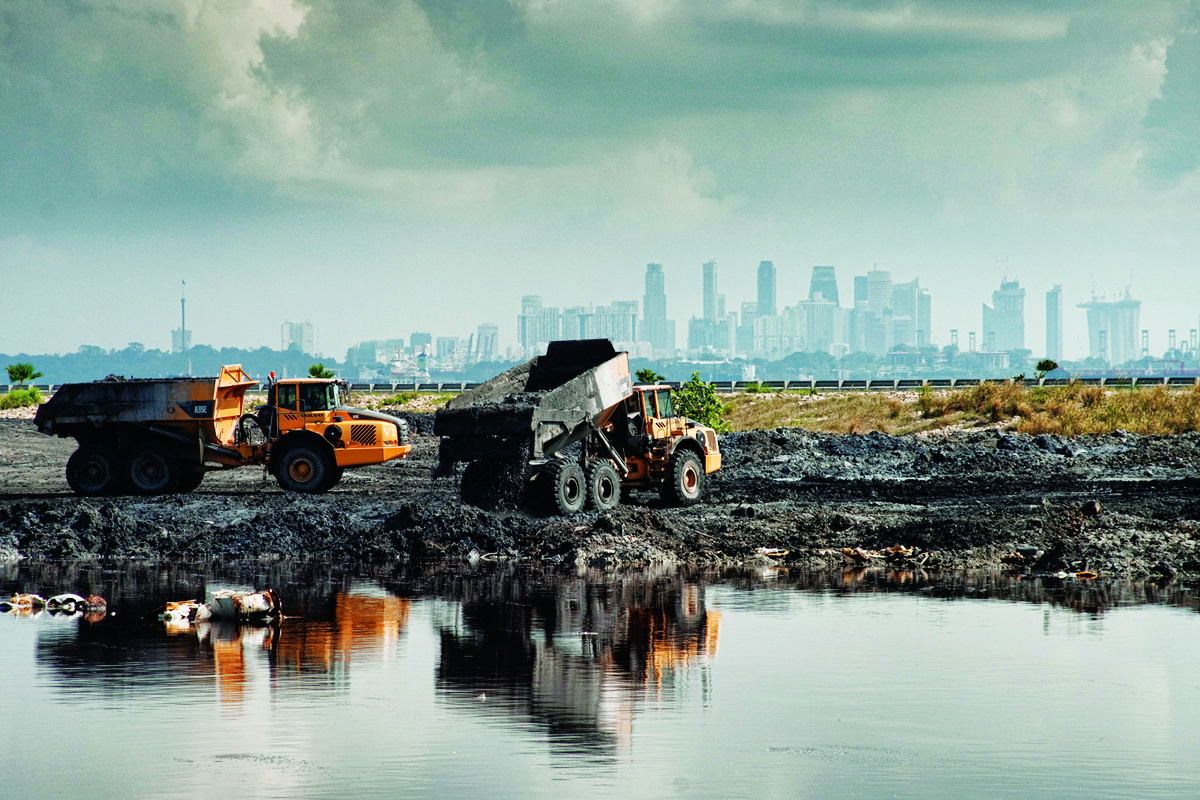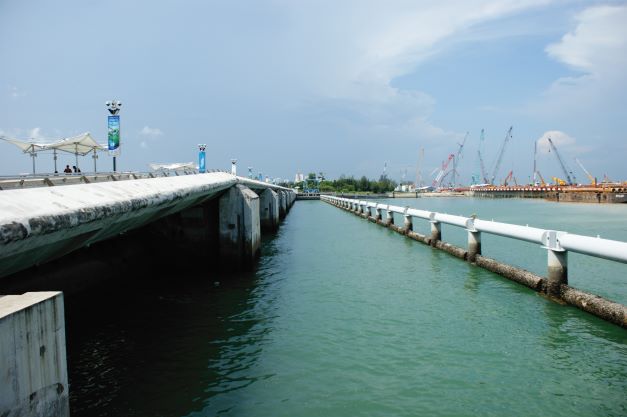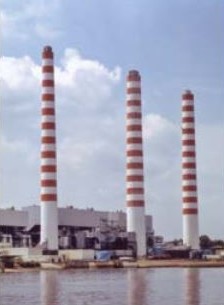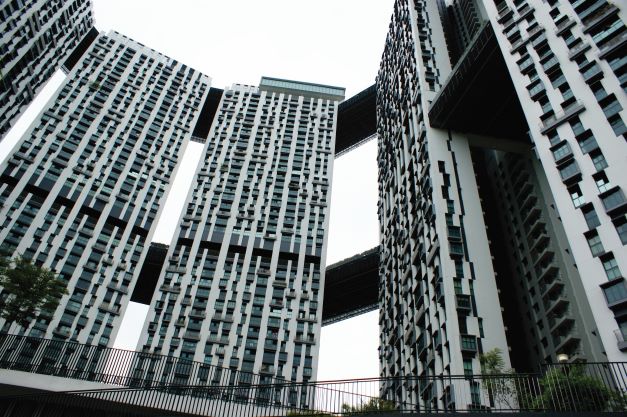Sustaining City State Singapore: Exploiting Global Hinterlands, Leaving Footprints Behind
There is a global quest for states and communities to find pathways to sustainable living. In the last 45 years, Singapore has come a long way in developing a more sustainable system of intra-urban living. The secret to Singapore’s success is taking care of its brown issues (refuse disposal, littering, sewerage, modern sanitation, clean water and energy) through public housing, innovating and managing urban transport systems, and reducing its water footprint by recycling and conserving water as well as creating more reservoirs.

Management of brown issues undergirds urban sustainability and this is achieved by attention to urban maintenance of buildings and infrastructure. These are green ideas that Singapore exports to other cities as part of its eco-city package. Sustainable Singapore, however, can only take place when the green software, environmentally friendly behaviour, becomes part of the genre de vie, or style of living, of Singaporeans.
Ever since the Brundtland Report introduced the concept of sustainable development in 1987 (World Commission on Environment and Development, 1987), the concept – despite its hollowness and contradiction – remains the capstone of governments and politicians trying to capitalise politically on environmental agendas. But new impetus is given in Japanese, German, American and South Korean tertiary institutes, where sustainability studies are a key academic programme. Sustainability studies cover not only environmental issues, but also a whole interdisciplinary agenda involving politics, economics, culture and society. Yet, the interchangeability of nature and society is not an easy task to operationalise, since nature interacts physically by material, biological and energy flows, while society and culture interact symbolically through knowledge, information and value systems. Over the decades, the links of nature and society have been cast in conceptual frameworks such as political ecology, eco-cities, industrial ecology, sustainable development, co-evolution, human ecology and eco-development. Notwithstanding these diverse relationships, there is urgency for sustainability studies given the growing failure of states, in both the developed and developing worlds, in maintaining economic and environmental balance sheets.
Given the importance of cities in the new globalised world, it is not surprising that three important books have made pertinent interventions on the rise of the world city: The City: A Global History (2006) by Joel Kotkin, World City (2007) by Doreen Massey, and Worlding Cities (2011), an edited work by Ananya Roy and Aihwa Ong. While these books have extolled the cultural virtues, economic engines and political capital of cities, the question left unanswered and open-ended is: how can governments sustain their cities? In most cases, cities have been ephemeral entities – few cities have sustained themselves over long periods much less as capital, global or world cities. The black box of sustainable cities is still to be uncovered and understood.
The challenge of modern urban living seems to fall into four areas:
(i) how can cities compete to attract the best talents to serve as catalysts of economic growth and societal development;
(ii) how can urban governments handle and manage the national and international non-skilled migrants in cities;
(iii) how can governments deal with rising disparities of wealth, inflation and food insecurity; and
(iv) how can cities become more sustainable from both an intra-urban and extra-urban context.

These issues are pertinent to Singapore, but for a city-state they are modified through the filter of foreign relations, international trade and inter-state migration protocols. The following analysis addresses these challenges by looking at other major intersecting themes. I advocate that the four urban challenges facing Singapore and other countries need rethinking, strategic planning and realignments at the national level.
First, in a globalising world, foreign policy becomes as important as domestic national policy. Foreign and national policies cannot be separated and disentangled easily. This is de facto policy in Singapore given that it is a city-state. Had it not been averted, the Greek debt default that loomed in 2011 would have had serious repercussions in the European Union and states around the world. The interrelationship between foreign and domestic policy is encapsulated in the opening line of Thomas Freidman and Michael Mandelbaum’s book, That Used to be Us: “This is a book about America that begins in China.”1
The international trade in foods leads to disruptions in food harvests, creating inflation with severe social and political repercussions. The global fluctuations of wheat production, for example, led Russia to stop exports of its wheat from mid-2010 onwards. The increase of wheat and food prices arising in part from climate change and food disruptions led to a chain of governments being toppled in North Africa (Tunisia, Egypt, Libya) in what is now known as the Arab Spring. For an open economy like Singapore that depends heavily on imported food, raw materials, energy, water and labour, and which has a large tourism sector and accounts for two percent of global trade, it will be difficult for any Singapore government to make a distinction between foreign and domestic policy. Every major international and regional issue has ramifications for Singapore’s economy and society. Given that Singapore is a city-state, the foreign and domestic policies have always been intertwined and hence the ruling government has been proactive in ensuring Singapore is on international radar screens and never marginalised in global debates.
Second, the increasing impact of climate change reverberates globally, unlike most environmental and ecosystem issues which are spatially delimited. As Tim Flannery argues, “our global civilisation is telekinetic” in that there is “movement at a distance without a material connection” and hence regional disruptions of wars, famines and diseases can have “dire consequences for humanity as a whole”.2 The recurrent issues of El Niño and La Niña in the eastern Pacific Ocean have created severe droughts and heavy rainfall respectively in Southeast Asian states. For instance, the 1997–98 forest fires in Indonesia arising from El Niño had massive environmental and human outcomes in the region. These environmental events have both direct and indirect impact on Singapore: the island state suffers periodically from haze created in Indonesia due to prolonged drought, and the prices of food and resource imports swing like a yo-yo due to weather and climatic effects on agricultural production.
Third, environmental and climate changes have across the board multisector implications in countries and cities. Environmental disruptions cannot be isolated and contained from their political, economic, social, cultural or security influences and impacts. Singapore’s costs of imported energy create domestic inflation in all sectors and these higher costs of production affect foreign companies and industries located in the city-state. Companies in Singapore have to consider the trade-offs between political stability, sound environmental management and high costs of production.
Many developed countries inadvertently focus on ensuring strict laws and environment-friendly practices at the expense of the global environment. One example is the strict adherence to environmental impact assessments, or EIAs. If every developed country implements clean environmental practices domestically by observing EIAs, what we would have is a NIMBY (not in my backyard) syndrome. Unfortunately, those clean domestic practices are not observed globally. Hence the Japanese might have strict laws protecting their domestic forests, but they are also the biggest importers of tropical hardwoods from Southeast Asia. Hong Kong might boast of superb EIA practices, but the industries across the border in China owned by Hong Kong entrepreneurs are the biggest polluters that provide poetic justice in Hong Kong through smog and air pollution. And while we might not have EIAs in Singapore, we certainly have effectively removed many polluting activities – pig farming has been eradicated in Singapore because of its pollution, but we import pork from neighbouring countries. In short, many developed countries and cities leave behind their ecological footprints in less developed countries. Hence, they might enjoy good environmental standards, but the cost of their consumption is borne by less developed and poorer communities.
Finally, the world has been developed under a political architecture of many autonomous and independent states, each pursuing selfish national goals and objectives. With environmental and climate changes and globalisation, it seems difficult to expect countries to abandon their territorial interests and national pursuits for the global common good. The United Nations is a hollow international institution without much political clout to set international goals. Hence we see endless debates over any agreement on climate change, from Kyoto and Bali to Copenhagen, Cancun and Durban. Yet one needs to be optimistic because at least the 192 countries can still engage in dialogue and debate even though solutions and compromises progress slowly. If countries in the developed world do not accept the need to ensure that developing countries embark on sustainable programmes, the world will be poorer for this, both ecologically and socially. It is thus not surprising that the latest United Nations Development Programme (UNDP) Report focuses on the theme of “Sustainability and Equity” – acknowledging that “environmental degradation intensifies inequality” while human development amplifies environmental degradation.3 Singapore’s growing wealth inequality, which is one of the highest in the world, is cause for political concern since studies show that states and societies with wide inequalities are likely to be socially unstable.
Given these interrelationships between states and ecosystems globally, no country or city can isolate itself from the reverberations of global forces (stock market fluctuations) and climate change outcomes (food harvests). The issue in the climate change debate lies with two alternatives: mitigation or adaptation. For the developing countries – the G77 (group of 77 developing countries) – mitigation (reducing CO2 emissions) based principally on reducing and curbing development goals and trajectories is a non-negotiable solution. This position falls squarely in the blame game between China and the United States, between BRICS (Brazil, Russia, India, China and South Africa) and developed countries, over the right to continue carbon-fuel-driven development, industrialisation and modernisation. Given this situation, most developing countries including Singapore have to double their efforts in seeking reliable and effective ways of adaptation to likely climate change scenarios of the future.
Singapore Challenges
Singapore, a city-state of 712 sq km and 5.18 million people (2011), is small in both area and population but it has economic prowess as a financial centre, oil refining base, trading and business hub, high-tech industrial city and mass communication and transport hub. Singapore faces four major challenges: the impact of globalisation and information technology; an aging population; climate change and related energy issues; and food security.
Given the exposed nature of its economy (finance, industry, transportation, tourism), Singapore is highly sensitive to global reverberations. Import contractions, trade fluctuations and financial instability in major trading economies impact the city-state’s economy. Singapore needs to adapt constantly to the international changing winds. The city-state’s small size and political clout mean its leadership must remain alert and percipient all the time. Globalisation is a double-edged sword for Singapore. If global markets become freer, Singapore can tap into them more readily and easily. However, greater integration with other economies means that national problems overseas will directly impact Singaporeans.
What are the options for Singapore in trying to remain a sustainable political and environmental city-state? Given its dependence on imported water from Malaysia, Singapore has been vulnerable to the changing nature of bilateral political relationships with Malaysia especially during the Mahathir–Lee years. In a way, this contentious bilateral relationship in the 1980s and 1990s spurred Singapore authorities to find ways of being self-sufficient in terms of water supply. With remarkable efforts in technological inputs, public water conservation and ecosystem management, the government did not need to extend the 1961–2011 water contract with Malaysia. Indeed, by 2061, when the last water contract with Malaysia ends, Singapore would be self-sufficient in water – a landmark achievement in reducing its water footprint. Singapore is asserting its independence in a life-sustaining and strategic resource.

The second, more difficult challenge, which is more directly related to climate change, is reducing energy footprint. The global economy and infrastructure are dependent on fossil fuel supplies of energy (coal, oil, gas), and domestic changes cannot take place unilaterally. The Singapore government is hoping to achieve some level of success as with its water systems by concentrating on alternative energy supplies. Singapore has steered its domestic energy demands to natural gas. And, in the long run, with its hot, sunny tropical weather, the government hopes to bank on solar power.

The third challenge is to encourage green technologies and more energy-efficient systems for all activities. In space-dependent Singapore, the authorities seem to be confronted with the dilemma of increasing car quotas to meet rising demand for cars from young Singaporeans, and the need to inculcate a public transport behavioural pattern. Indeed, the Singapore authorities can do more to improve public transportation. There is no need to ensure that all Mass Rapid Transit (MRT) lines must be fully utilised – if more MRT lines with a broader rail network were available, the rush-hour peak periods could be reduced because commuters would be able to take other lines to go home. It seems illogical to ensure that every MRT station should have high train-carrying capacities. One classic case was the building of numerous public institutions (including the Ministry of Education and the Civil Service College) to boost traffic around the Buona Vista MRT station because surveys had found the station saw the least passenger traffic. Currently, the MRT network is still too limited and hence peak hours create exasperating situations for commuters.
I do not see why Singaporeans would need to drive cars to work and urban leisure-entertainment if there is dependable and convenient public transport. Instead of building more roads and highways, the government needs to build a more integrated, efficient and reliable MRT system. Singaporeans also need to take lessons from London, Hong Kong and Tokyo with regard to being comfortable with using the metro-transit and mass transport systems. Indeed, one will find in these cities relatively few traffic problems on weekdays because most urban commuters use the underground transit system. There is a need to remove from the psyche of Singaporeans the status symbol of driving cars; the car should not be equated with success and having arrived in life. Hence, Singapore’s MRT system should also serve the rich living in landed properties and condominiums instead of encouraging them to commute by car.
Singapore is a compact city because of its lack of spatial choice. This city is subject to deliberate planning because it cannot survive on spontaneous developments or succumb to the spatial adjustments arising from economic changes. Hence building an intra-urban eco-city is paramount. The secret of Singapore’s eco-city success has been its relentless Housing and Development Board (HDB) public housing schemes, which currently house some 82 percent of the population. Public housing provides many environmentally friendly urban advantages: clean water; efficient, safe and clean energy supplies; modern sanitation; effective refuse and garbage disposal systems; and a living environment with good public health and hygiene.

The essential ingredient that Singapore’s public housing underscores is efficient and effective maintenance of its 15 satellite towns and thousands of flats. Unfortunately, the institutionalisation of urban maintenance systems is missing in many cities, especially in emerging states. If city administrators do not pay attention to vigilant cleaning, upgrading and repair of buildings and the urban infrastructure, sustainable urban environments will remain pipe dreams. In many cities in developing countries, one finds building booms taking place, massive infrastructures developed and iconic buildings erected, but what is sadly missing is the daily maintenance of buildings, roads, gardens, parks and the urban infrastructure. Intra-urban sustainability begins with the implementation of effective maintenance services to ensure brown issues (pollution, sewerage, refuse, clean water and electricity) are managed correctly and effectively. In Singapore, this is legislated and implemented efficiently because the government is the largest land owner and the biggest real estate agency. The government, the HDB and other statutory boards set the benchmarks for keeping the city clean and green, and these are translated to and emulated by the private sector.
With increasing information technologies and the diffusion of globalisation, some academics have said that rural and urban demarcations are blurring. According to geographer Jonathan Rigg,4 urban and rural areas in Southeast Asia have become one seamless continuous landscape. Singaporean architect Tay Kheng Soon refers to this as “rurbanization”, while urban geographer Terry McGee postulates that urban areas in Indonesia have developed into desakotas (village-city spatial entities).5 Despite these integrated conceptions of an expanding urban domain, cities still remain distinctive spatial entities in many countries, covering only 1 percent of global land area but consuming over 65 percent of resources.
These rural-urban integrated conceptualisations underscore the best example of future eco-cites. The ideal eco-city must provide a seamless integration of rural and urban activities and functions with minimal negative environmental fallout and ecological disruption. Singapore cannot aspire to be a prototype eco-city because it does not have a domestic hinterland to tap on and integrate. But what it has offered to other countries is a model of intra-urban sustainability. The moot question is that the city-state needs to ensure that its oasis of economic prosperity and its Edenic urban garden do not leave ecological footprints with future negative effects in other countries and communities. We need to be law-abiding and environmentally conscious Singaporeans as well as ecologically responsible global citizens. Despite Singapore’s unique geographic and political status as a city-state, there are lessons that can be learnt from other cities and countries. At the end of the day, Singapore’s sustainability lies in finding the correct political governance of keeping the future navigable and viable as well as accessible – a quest other countries would like to emulate.
REFERENCES
Flannery, T. (2006). The weather makers: How man is changing the climate and what it means for life on earth. New York: Grove Press. (Not available in NLB holdings)
Friedman, T., & Mandelbaum, M. (2011). That used to be us: How America fell behind in the world it invented and how we can come back. London: Little, Brown. (Call no.: R 973.932 FRI)
Kotkin, J. (2006). The city: A global history. New York: Modern Library. (Call no.: R 307.7609 KOT)
Massey, D. (2007). World city. Cambridge, Uk: Polity Press.
McGee, T. (1991). ‘The emergence of desakota regions in Asia: Expanding a hypothesis’. In N. Ginsburg, B. Koppel & T.G. McGee (eds.). The extended metropolis: Settlement transition in Asia. Honolulu: University of Hawaii Press, pp. 3–5. (Call no.: RSING 307.76095 EXT)
Rigg, J. (2001). More than the soil: Rural change in Southeast Asia. London: Prentice Hall.
Roy, A., & Ong, A. (2011). Worlding cities: Asian experiences and the art of being global. Oxford: Wiley-Blackwell. (Call no.: R 307.76095 WOR)
United Nations Development Programme (UNDP). (2011). Human development report 2011 sustainability and equity: A better future for all. New York: United Nations Development Programme. Retrieved from UNDP website.
World Commission on Environment and Development. (1987). Our common future. Oxford: Oxford University Press.

